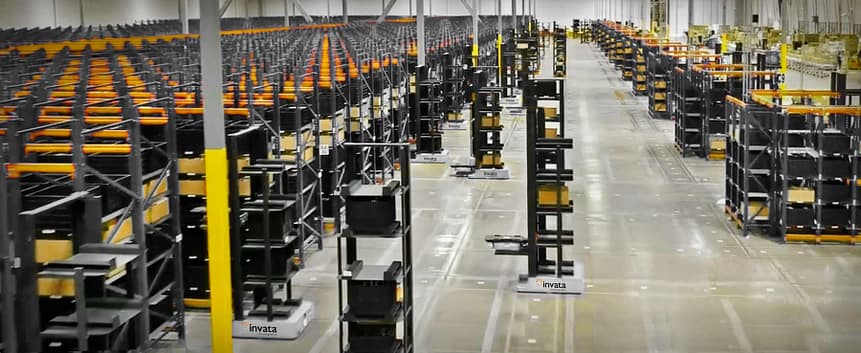Remember how MTV Unplugged disrupted the music industry back in the ‘90’s?
Suddenly electric guitar legends where winning Grammys for acoustic performances and everybody was cashing in on the popularity of being unplugged.
Autonomous mobile robots (AMRs) are doing something similar to the supply chain industry today as the toolset of warehouse optimization expands to accommodate new technologies — and new approaches to problem solving emerge as a result.
What were completely foreign ideas just a few years back are now a smart way to tackle supply chain challenges.
Conveyors Unleashed. Sorters Unchained. ASRSs Off the Rails.
It’s a new world in which equipment that was once bolted to the warehouse floor is now free to roam around the warehouse… unplugged.
And warehouse automation system designers, now unbound by the limitations of traditional technology, are free to explore new approaches to solving old problems.
The results are AMR-supported automation systems that provide enhanced levels of optimization over and above the already impressive optimization of manual processes realized by more traditional fixed-asset automation technologies.
With the truly dramatic and disruptive efficiencies being delivered by robotics, it’s little wonder why this emerging technology is rapidly becoming a warehouse automation staple — much like a musician becomes an overnight success who has spent years trying to get traction.
It’s also little wonder why smart companies are cashing in on the savings offered by AMR-supported automation.
So how can you?
Three steps will get you pointed in the right direction.
Step 1: Think Different
Yes, we’re borrowing from an old Apple ad campaign here (also from the 90’s in keeping with our theme) to highlight the need for creative thinkers.
Change requires creative thinking. New approaches to problem solving begin there.
Those that can envision a different way of doing things are the ones that can solve problems in new ways and capitalize on change.
Those that can’t, don’t.
So find a provider partner that not only has the robotics, but has the vision to integrate it into a comprehensive solution.
And while you’re at it, make sure your provider can back up their vision with mathematical certainty and the scientific proof points to convince all the members of your team that the proposed solution will yield the expected returns.
Step 2: Think Holistic
There are lots of robotics companies on the market at present promoting robotic solutions focused on tackling some of the lowest hanging of the warehouse automation and fulfillment challenges.
Their systems can definitely help solve some of the most pressing fulfillment challenges. But it’s important to keep in mind that they do so in ways that require recipients to rely on multiple providers to solve their overall operational challenges.
Optimization is best derived from a holistic systems approach rather than one that is built from ad-hoc solutions.
And while one-off AMR solutions that tackle a large percentage of a company’s warehousing challenges can be enticing in the short-term, — especially to smaller companies taking the initial steps toward automation, in the long term they can produce cobbled together solutions with lots of potential for less-than-optimal performance between disparate systems.
The communications latency alone between disparate subsystems can create processing delays large enough to diminish the edge a company had hoped to gain through a new process.
So seek solutions versus products. And don’t buy into the 80-20 sell. That remaining 20% can cost you more than you think. Team with provider partners that not only offer robotics and vision, but also offer a comprehensive holistic approach to optimizing your entire operation.
And keep in mind that while robotics are providing very promising advancements, holistic solutions providers rely on the technologies that best solve your unique challenges, whether emerging or mature in nature.
So don’t get too distracted by the shiny objects, even if they do look really cool.
Step 3: Think Software
When you watch an AMR picking a tote or case from a warehouse shelf or see pallets of cases dance across the floor autonomously on route to picking stations, it’s easy to get so consumed by the performance that you overlook the intelligence behind the robotics ballet.
But it’s the intelligence that maters.
Autonomous Mobile Robots, like any equipment technologies, are only as good as the software that runs them. And given the multitude of technologies in a typical automated fulfillment operation, software is what matters most.
System performance and even system payback and ROI are all directly tied to the software that runs your system versus the hardware from which it is built. And the better the software, the greater the returns — often in spite of the equipment used.
In fact, it’s the software that ensures:
- Seamless integration between processes
- Robust algorithms that constantly regulate throughput
- Millisecond decision-making capabilities and database queries
- A data-driven AI process that factors in handling costs, shipping costs, and customer promise dates when determining the best processing method for each order.
So team with provider partners that not only have robotics technology, vision, and a holistic approach to operational optimization, but also have a proven warehouse software platform that is up to the task of automating your entire warehouse / fulfillment / distribution operation.
And if you want to take advantage of the enhanced levels of optimization that robotics can bring you, click the button below and let us show you how we can help.
Walter High is VP Marketing at MSI Automate, where he has worked since 2012.

